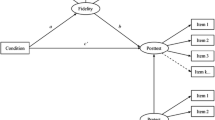Abstract
An English teacher and peer tutors used a system of least prompts procedure to teach 4 secondary students with moderate disabilities to write letters within a secondary composition class setting. While students without disabilities simultaneously worked on composition assignments, they taught the students with disabilities to write letters that included the following 4 components: (a) heading, (b) greeting, (c) content body, and (d) closing. A multiple probe design across students evaluated the effectiveness of the procedure. The English teacher collected supplementary data as to the attitudes of the composition class students toward the students with disabilities who participated in their class. Results indicate that it is possible to reliably incorporate direct instruction on functional academic skills within an inclusive setting. However, support for the regular education classroom teacher is desirable. Issues as to isolation within the academic setting and limited teacher interaction are discussed.
Similar content being viewed by others
REFERENCES
Billingsley, F. F. (1993). In my dreams:Aresponse to some current trends in education. J. Assoc. Persons Severe Handicaps 18: 61–63.
Browder, D. M., and Snell, M. E. (1993). Functional academics. In Snell, M. E. (ed.), Instruction of Students With Severe Disabilities, Merrill, New York, pp. 442–479.
Collins, B. C., Branson, T. A., and Hall, M. (1995). Teaching generalized reading of cooking product labels to adolescents with mental disabilities through the use of key words taught by peer tutors. Educ. Train. Ment. Retard. Develop. Disab. 30: 65–75.
Collins, B. C., Hall, M., and Branson, T. A. (1997). Facilitating inclusion of students with moderate to severe disabilities by involving peers in the instruction of leisure skills. Except. Child. 63: 499–512.
Collins, B. C., and Stinson, D. M. (1995). Teaching generalized reading of product warning labels to adolescents with mental disabilities through the use of key words. Exceptionality 5: 163–181.
Colyer, S. P., and Collins, B. C. (1996). Using natural cues within prompt levels to teach the next dollar strategy to students with disabilities. J. Spec. Educ. 30: 309–315.
Doyle, P. M., Gast, D. L., Wolery, M., Ault, M. J., and Farmer, J. (1990). Use of constant delay in small group instruction: Study of observational learning. J. Spec. Educ. 23: 369–385.
Gast, D. L., Doyle, P. M., Wolery, M., Ault, M. J., and Farmer, J. (1991). Assessing acquisition of incidental information by secondary age student with mental retardation: A comparison of response prompting procedures. Am. J. Ment. Retard. 96: 63–80.
Kleinert, H. L., Kearns, J. F., and Kennedy, S. (1997). Accountability for all students:Kentucky's alternate portfolio assessment for students with moderate and severe cognitive disabilities. J. Assoc. Persons Severe Handicaps 22: 88–101.
Meyer, L. (ed.). (1994). [special issue]. J. Assoc. Persons Severe Handicaps 19(4).
Miler, M. H., Noland, K., and Schaaf, J. (1990). A guide to the Kentucky Education Reform Act of 1990, Legislative Research Commission, Frankfort, KY.
Moon, M. S., and Inge, K. (1993). Vocational preparation and transition. In Snell, M. E. (ed.), Instruction of StudentsWith Severe Disabilities, Merrill, New York, pp. 556–587.
Sailor, W., Gee, K., and Karasoff, P. (1993). Full inclusion and school restructuring. In Snell, M. E. (ed.), Instruction of Students With Severe Disabilities, Merrill, New York, pp. 1–30.
Slaton, D. B., Schuster, J., and Collins, B. (1994). Afunctional approach to academics instruction. In Cipani, E. C. and Spooner, F. (eds.), Curricular and Instructional Approaches for Persons With Severe Disabilities Allyn and Bacon, Boston, MA, pp. 322–350.
Stainback, S., and Stainback, W. (1992). Including students with severe disabilities in the regular classroom curriculum. Preventing Sch. Failure 37: 26–30.
Tawney, J. W., and Gast, D. L. (1984). Single Subject Research in Special Education. Charles E. Merrill, Columbus, OH.
Waldron, K. A. (1996). Introduction to a Special Education: The Inclusive Classroom, Delmar Publishers, Albany, NY.
Wisniewski, L., and Alper, S. (1994). Including students with severe disabilities in general education settings. Remedial Spec. Educ. 15: 4–13.
Wolery, M., Ault, M. J., and Doyle, P. M. (1992). Teaching Students With Moderate to Severe Disabilities, Longman, New York.
York, J., Vandercook, T., MacDonald, C., Heise-Neff, C., and Caughey, E. (1992). Feedback about integrating middle-school students with severe disabilities in general education classes. Except. Child. 58: 244–258.
Author information
Authors and Affiliations
Rights and permissions
About this article
Cite this article
Collins, B.C., Branson, T.A., Hall, M. et al. Teaching Secondary Students with Moderate Disabilities in an Inclusive Academic Classroom Setting. Journal of Developmental and Physical Disabilities 13, 41–59 (2001). https://doi.org/10.1023/A:1026557316417
Issue Date:
DOI: https://doi.org/10.1023/A:1026557316417




